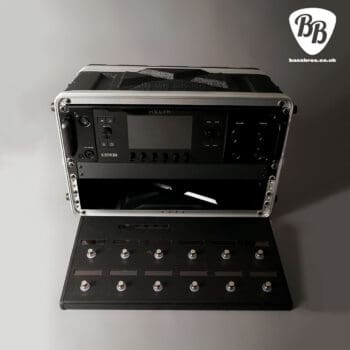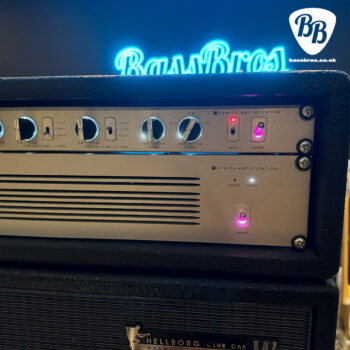Bass Guitar Modelling: The Perfect Pedals For A Bassist?
After diving into the hot topic of modellers vs amps last month over on the GuitarGuys blog, it made me think about how modellers feel like they’ve had a surprisingly different impact in the world of bass guitar. The modelling world has largely been designed and marketed towards guitarists from an outside perspective – they get a wide selection of amps, cabs, effects, and more, while bassists get a handful at best and, in some cases, absolutely nothing. But then there’s a horde of bassists building pedalboards around the venerable HX Stomp and making wild sounds from it.
Is bass guitar modelling just as useful? Or is it a cool technology that guitarists get more out of than we do? Let’s dive in.
What Exactly Is Bass Guitar Modelling?
Bass amp modelling uses digital signal processing (DSP) to recreate the sound and behavior of real amps, cabinets, and effects. Instead of hauling an Ampeg SVT and an 8×10 fridge to every gig, you can go direct into the front-of-house with a signal that intends to simulate that full analog rig – all in the form factor of a small pedal. It sounds like an absolute slam dunk. Many working bassists are more than used to plugging an XLR into their preamp DI pedal for front-of-house to do with as they see fit, so having an on-board unit that can give us some more tones and fun tools to play with sounds ideal. So why don’t you see as many modellers on bass player gigboards?
Modern modellers like the Line 6 Helix and the Neural DSP Quad Cortex offer bass-centric options, but amp and effect selection is still limited for bass in comparison to guitar, even as platforms have matured, and it has certainly sent the message that modelling technology is for guitarists over bassists.
Why Guitarists Adopted Modelling First
On the one hand, bassists seem like the ideal candidates for modelling technology. Many live and studio situations ask for a DI out from your bass pedalboard, and the days of bringing a full bass amp rig are long gone for all but the biggest shows. And in all seriousness, the range of quality preamp pedals has made the need for a live amp and cab moot. But why is it that modellers have taken so long to catch on?
It’s easy to see why guitarists jumped on the digital bandwagon early. Guitar tone depends heavily on amp color, drive, and effects, and modelling technology gave players instant access to hundreds of tones that would otherwise cost a fortune in real gear. A modeller that achieves 90% of an analog pedal’s sound, but can produce that level of quality over 20 different effects, suddenly becomes an incredibly cost-effective choice for any guitarist. The demand for a wide range of tones and effects makes this yet more inviting, and it doesn’t stop guitarists from still making use of their beloved valve amps as the final output.
Bassists, meanwhile, tend to chase consistency more than variety. We’re often the glue, not the fireworks. A clean, solid tone that holds the mix together usually matters more than having a dozen amp flavors or multiple stages of gain, distortion, or fuzz.
To make matters worse, early modelling units struggled with low-end accuracy – some still do in extreme cases. Latency, fizz, and a lack of punch were common issues, and those artifacts are way more noticeable on bass than on guitar. So while guitarists were happily experimenting with modellers, most bass players stayed loyal to their trusty preamp DI.
How Good Is Bass Modelling Today?
Fast forward to 2025, and bass modelling has made huge strides. The realism, dynamic feel, and depth of modern units are at a stage where pro musicians feel comfortable taking them out on the road. Darkglass released one of the first prosumer-grade modellers designed specifically for bassists in the Darkglass Anagram and is an absolute powerhouse piece of kit. The HX Stomp continues to stride forward as the heart of many pedalboards. There’s never been a better time to dive into the world of modelling for bass.
Why Modelling Makes Sense for Bassists
1. Portability That Saves Your Back
Let’s be honest – bass gear is heavy. More people ask how heavy a bass is before they try it to see if it even sounds good and plays well when enquiring about used basses at BassBros! When you factor in the rest of our gear, a load-in can quickly turn into a workout – especially when an amp and cab are involved. A modeller, on the other hand, fits in your gig bag. For touring or fly dates, that’s a no-brainer.
2. Consistent Sound Everywhere
Venue backlines are unpredictable. With a modeller or preamp DI, you can send the same tone to front-of-house night after night. Engineers love the consistency, and you can skip the “is my cab mic’d right?” anxiety. If you’re still after a bit of on-stage rumble, most modellers will let you output a second parallel signal to a small amp or cab that you can mess around with – without affecting the front-of-house feed.
3. Studio Power Without the Noise
Recording at home? Bass modelling gives you a fully mixed tone without mic bleed, amp hum, or angry neighbors. Modelling plugins like AmpliTube 5, Neural DSP, and Plugin Alliance let you audition multiple amp and cab combos until the bass sits perfectly in the mix. It also makes reamping and tone sculpting far easier, as you can take a dry signal and run it through your modeller to endlessly tinker with your tone.
4. Perfect Fit for Modern Rigs
Today’s bassists are running much more complex setups than 20 years ago. It’s not uncommon to see a bassist running in-ear monitors, MIDI switching, and hybrid setups with backing tracks or synth bass layers to provide the required tonal variety across a gig. Digital modelers slot right into that workflow. You can even program song-by-song tone changes or use snapshots for different sections – clean verse, dirty chorus, slap solo – all with one stomp. The age of tech is a paradise for a bassist who likes to get stuck in, and a modeller will be the conduit for your scientific pursuits.
The Catch: What Modelling Still Can’t Replace
Even with all these wins, some bassists still feel a disconnect that can be difficult to capture.
1. The Missing “Feel”
Digital rigs can sound amazing, but they can never replicate the feel of pushing air from a big cab onstage as a result of your playing. That physical interaction between speaker and player is tough to reproduce through IEMs or studio monitors, and modellers can never fully capture the effect.
2. Simpler Tonal Needs
Most of us don’t need fifty amp models, a horde of drives, or 12 unique pedal sounds. One solid tone that cuts through the mix and responds well to playing dynamics usually does the job for many gigs. If you’re a bassist who knows exactly what you like and aren’t fussed about having a wide tonal repertoire,
3. Latency and Headroom
While much improved, latency is still a reality in the digital world – even if it’s just a few milliseconds. Realistically, it should be imperceptible to us, but many have claimed they can feel the disconnect. Add in handling the wide dynamic range of slap or fingerstyle playing without clipping takes some careful gain staging.
Hybrid Rigs: The Best of Both Worlds
A lot of pros are now running hybrid setups that combine digital convenience with analog tone.
For example, you can use a modern popular preamp pedal as your primary preamp, and either run it before or after a modeller for cab IRs, EQ, and compression. This gives you that real analog grit and feel with the flexibility of digital routing.
Others use modelers for specific roles – like silent stages, travel gigs, or quick recording sessions – while keeping a full amp setup for bigger shows. It’s not an all-or-nothing choice anymore.
Is Bass Modelling Really as Useful as Guitar Modelling?
That depends on what kind of player you are.
For guitarists, modelling completely replaced complex pedalboards and amp stacks. For bassists, it’s more of a power tool – one that solves practical problems rather than reinventing tone itself.
If you:
-
Tour or fly often
-
Record at home
-
Play on silent stages
-
Need a consistent tone across a range of backlines
…then bass modelling is a total win.
But if you live for the feel of a tube amp shaking the stage or don’t want to hop between presets and menus song-to-song, you might still prefer a traditional rig you can trust.
The Bottom Line
Bass guitar modelling has officially grown up. The tones are authentic, the flexibility is unmatched, and the gear keeps getting lighter and smarter.
That said, bass is a different beast from guitar. We live in the low end, where clarity and feel matter more than anything else. Modelling might not replace analog gear completely, but it has earned its place as an essential modern tool.
For many players, the future isn’t digital or analog – it’s both. The choice isn’t about abandoning tradition, but about expanding what’s possible. Whether you’re sending DI to front-of-house, tracking in your bedroom, or touring with a pedalboard rig, bass modelling can make your life easier without sacrificing tone.
And if it saves your back while sounding killer? That’s just good engineering.
Whichever you choose, make sure you pair it with a dream bass. Fortunately, we’re probably got it in stock. Check out our range of vintage and used bass guitars at BassBros and book an appointment today.

Worldwide Shipping
available with all orders

Sell or Trade
Sell/trade your bass or find your next bass

Have a question?
Want to know more?
Join our newsletter.
An update on the latest new guitars at BassBros,
live video demo’s, promotional offers and giveaways.




